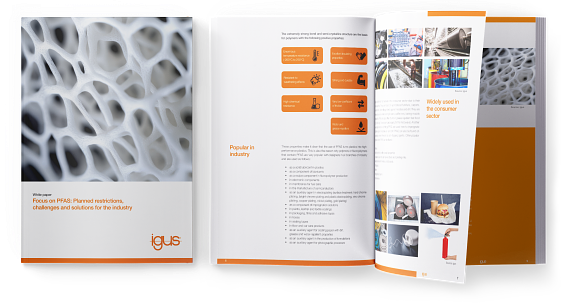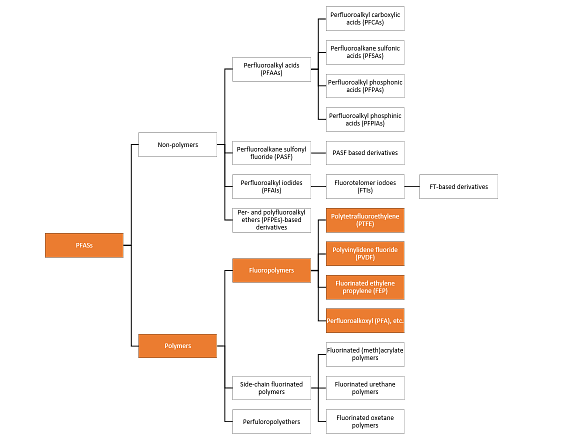Güzeller Org. San. Bölg. Galvano
Teknik San. Sit. Cumhuriyet Cad. 2/32
P.K. 41400 Gebze / Kocaeli
Güzeller Org. San. Bölg. Galvano
Teknik San. Sit. Cumhuriyet Cad. 2/32
P.K. 41400 Gebze / Kocaeli

Per- and polyfluoroalkyl substances (PFAS) are industrial chemicals that are used in numerous industrial processes and consumer products due to their special technical specifications. They essentially consist of carbon (C) and fluorine (F) atoms. Apart from this, PFAS molecules can have completely different structures, which means that they can have many different specifications. Diagram 1 gives an overview of the classification of PFAS, initially into polymers and non-polymers.
PFAS can be gaseous, liquid or solid. According to the OECD database, the group of substances includes more than 4,700 different compounds, according to the EPA (Environmental Protection Agency) more than 9,000 and according to the EU Commission even more than 10,000 compounds. From this, you can see that it is neither a unique nor a constant value. The stated value is usually based on estimates.

In the subgroup of perfluoroalkyl substances (non-polymers), the compounds perfluorooctanoic acid (PFOA) and perfluorooctane sulfonic acid (PFOS) have been studied the most thoroughly. Like many PFAS, these two compounds are persistent and can now be found in the environment, the food chain and in people. PFOA and PFOS have a proven negative impact on health. Together with PFHxs and PFNA, they account for 90% of the current contamination with PFAS.
In the subgroup of polymers, a distinction is made between fluoropolymers/fluoroplastics and polymers with fluorinated side chains. The fluoropolymers consist of a carbon chain with directly attached fluorine atoms. This makes them so strong that they cannot break down into toxic substances. Fluoropolymers are considered non-toxic and non-bioaccumulative, i.e. they cannot accumulate in organisms. The only danger is the possible use of toxic additives during production in the form of emulsifiers. Fluoropolymers are used, for example, in coatings, seals and cable insulation. PTFE is a fluoropolymer.
Polymers with fluorinated side chains also consist of a carbon chain, but with lateral carbon chains to which the F-atoms are first attached. As a result, these polymers are less strong, and there is a risk of losing the side chains. They are used, for example, as impregnating agents.
The use of PFOS has been largely banned since 2006 and that of PFOA since July 2020. Our certification can be found here. Five European countries (Germany, the Netherlands, Denmark, Sweden, Norway) submitted a proposal for a general restriction of PFAS, which was published by ECHA (European Chemicals Agency) on 7th February 2023. This proposal is a first step in a long regulatory process and will be examined by all stakeholders.
The first phase of consultation by all stakeholders runs from 22nd March until 22nd September 2023. The proposed PFAS regulation would be likely to come into force in EU member countries in 2026 at the earliest. Transitional periods of up to 13 years are possible from the time they come into force.
US: The EPA has issued a final regulation adding five PFAS substances to the list of over 170 PFAS substances that are reportable under the Toxics Release Inventory ("TRI"), a central database for public reporting of chemicals. Fluoropolymers are not included in the TRI list.